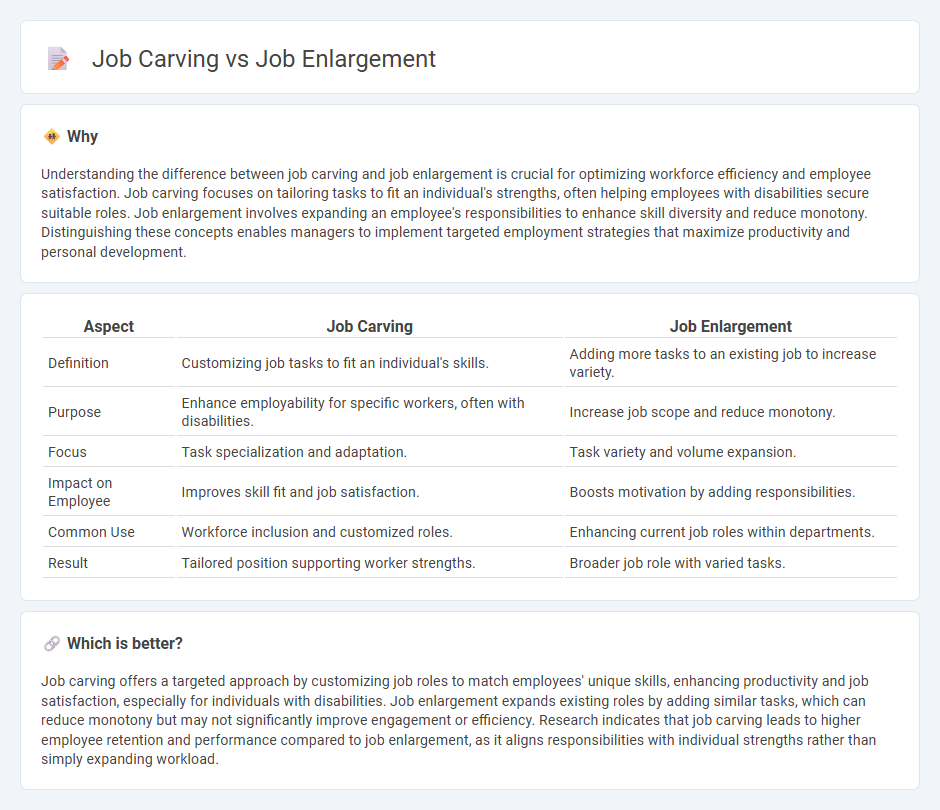
Job carving involves customizing job roles by dividing tasks to fit an employee's unique skills, boosting productivity and job satisfaction. Job enlargement expands an employee's responsibilities horizontally, adding similar-level tasks to increase variety and reduce monotony. Explore the benefits and strategies of job carving and job enlargement to enhance workforce efficiency and employee engagement.
Why it is important
Understanding the difference between job carving and job enlargement is crucial for optimizing workforce efficiency and employee satisfaction. Job carving focuses on tailoring tasks to fit an individual's strengths, often helping employees with disabilities secure suitable roles. Job enlargement involves expanding an employee's responsibilities to enhance skill diversity and reduce monotony. Distinguishing these concepts enables managers to implement targeted employment strategies that maximize productivity and personal development.
Comparison Table
| Aspect | Job Carving | Job Enlargement |
|---|---|---|
| Definition | Customizing job tasks to fit an individual's skills. | Adding more tasks to an existing job to increase variety. |
| Purpose | Enhance employability for specific workers, often with disabilities. | Increase job scope and reduce monotony. |
| Focus | Task specialization and adaptation. | Task variety and volume expansion. |
| Impact on Employee | Improves skill fit and job satisfaction. | Boosts motivation by adding responsibilities. |
| Common Use | Workforce inclusion and customized roles. | Enhancing current job roles within departments. |
| Result | Tailored position supporting worker strengths. | Broader job role with varied tasks. |
Which is better?
Job carving offers a targeted approach by customizing job roles to match employees' unique skills, enhancing productivity and job satisfaction, especially for individuals with disabilities. Job enlargement expands existing roles by adding similar tasks, which can reduce monotony but may not significantly improve engagement or efficiency. Research indicates that job carving leads to higher employee retention and performance compared to job enlargement, as it aligns responsibilities with individual strengths rather than simply expanding workload.
Connection
Job carving and job enlargement both aim to enhance employment opportunities and employee satisfaction by tailoring job roles to better fit individual strengths and organizational needs. Job carving involves customizing specific tasks from existing roles to create new positions suited to unique worker abilities, often benefiting individuals with disabilities. Job enlargement expands the scope of an employee's duties by adding varied tasks, increasing job variety and reducing monotony, which complements job carving's focus on meaningful job design.
Key Terms
Task Variety
Job enlargement increases task variety by expanding the number of tasks an employee performs, enhancing skill diversity and reducing monotony. Job carving customizes task variety by selectively combining specific tasks from different roles to better fit an employee's strengths and preferences. Explore the nuances and benefits of each approach to optimize job design and improve workforce engagement.
Customization
Job enlargement increases customization by expanding an employee's tasks to include more varied responsibilities, enhancing skill diversity and engagement. Job carving customizes roles by selectively focusing on specific tasks tailored to an individual's strengths and abilities, promoting efficiency and job satisfaction. Explore the distinct advantages of job enlargement and job carving to optimize role customization in your workforce.
Employee Strengths
Job enlargement broadens an employee's responsibilities by adding similar tasks, enhancing skill diversity and job satisfaction through expanded roles. Job carving customizes job duties to align with an employee's specific strengths, optimizing performance and engagement by tailored task allocation. Explore how these strategies harness employee strengths to improve productivity and workplace fulfillment.
Source and External Links
What Is Job Enlargement? Definition, Benefits and Examples - Simpplr - Job enlargement is the process of increasing the number of tasks an employee performs within their current role to diversify work and boost job satisfaction, such as adding maintenance and quality control tasks to assembly line workers' duties in manufacturing or expanding nurses' roles in healthcare to include patient discharge coordination and assessments.
What Is Job Enlargement? Meaning, Benefits and Examples - Indeed - Job enlargement involves broadening the scope of an employee's job by combining tasks of similar responsibility levels, aiming to increase engagement and skill diversification, for example by increasing the number of claims processed or providing training and mentoring to expand roles.
Job enlargement - Wikipedia - Job enlargement is the horizontal expansion of job duties within the same level, combining various activities to reduce repetition and monotony, thus motivating employees by increasing their exposure and efforts toward organizational goals, often requiring retraining.
 dowidth.com
dowidth.com